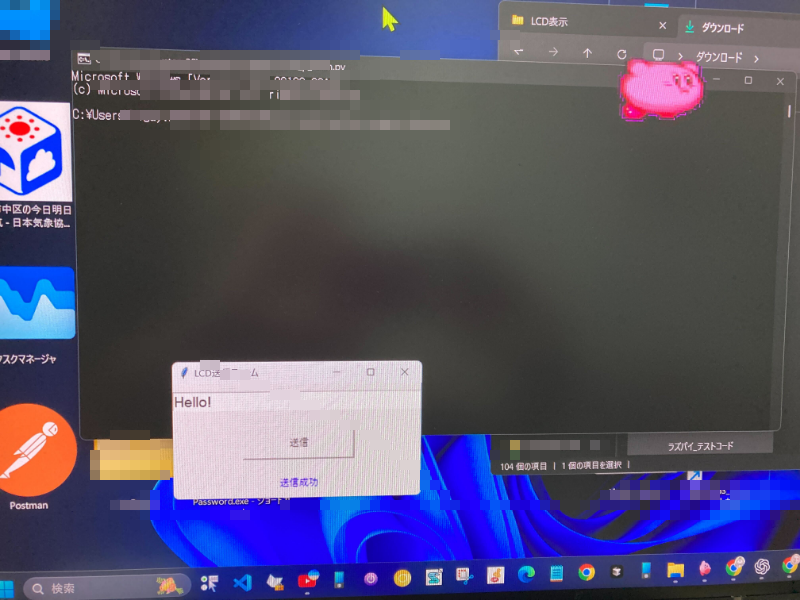Raspberrypi pico でデータを受信し、LCDディスプレイに表示
開発環境
- Raspberrypi_pico: thonny
- PCからの送信: メモ帳
Pin配置
✅ GPIOと物理ピン対応表
Raspberry Pi Picoでは、GPIO番号と物理ピン番号が異なるため注意が必要です。
| 物理ピン | GPIO番号 | 用途例 |
|---|
| 40 | GPIO21 | 未使用またはI2C切替用 |
| 38 | GPIO20 | 未使用またはI2C切替用 |
| 22 | GPIO17 | SCL(I2Cクロック) |
| 21 | GPIO16 | SDA(I2Cデータ) |
✅ I2C 初期化コード(GPIO16 / GPIO17 使用)
from machine import I2C, Pin
i2c = I2C(0, scl=Pin(17), sda=Pin(16), freq=400000) # GPIO17=SCL, GPIO16=SDA
print(i2c.scan()) # I2Cデバイスが見つかればアドレスが表示される
```main.py
from machine import Pin, I2C
from pico_i2c_lcd import I2cLcd
import sys
# LCDの初期化
i2c = I2C(0, scl=Pin(17), sda=Pin(16), freq=400000)
lcd = I2cLcd(i2c, 0x3F, 2, 16)
lcd.clear()
lcd.putstr("USB Listening...")
# ASCIIフィルター関数(英数字+記号のみ許可)
def ascii_only(text):
return ''.join(c for c in text if 32 <= ord(c) <= 126)
# 入力バッファ
buffer = ""
# メインループ
while True:
try:
char = sys.stdin.read(1)
if char == '\n':
clean_text = ascii_only(buffer)
lcd.clear()
lcd.putstr(clean_text[:16]) # 16文字以内にカット
print("Received:", clean_text)
buffer = ""
else:
buffer += char
except Exception as e:
lcd.clear()
lcd.putstr("Error occurred")
print("Error:", e)
break
lib/pico_ic2_lcd.py
Raspberrypi pico 内に lib フォルダを作成し、pico_ic2_lcd.py を作成し以下のコードを書く
pico_ic2_lcd.py
# forked from https://github.com/T-622/RPI-PICO-I2C-LCD/
import utime
import gc
from lcd_api import LcdApi
from machine import I2C
# PCF8574 pin definitions
MASK_RS = 0x01 # P0
MASK_RW = 0x02 # P1
MASK_E = 0x04 # P2
SHIFT_BACKLIGHT = 3 # P3
SHIFT_DATA = 4 # P4-P7
class I2cLcd(LcdApi):
#Implements a HD44780 character LCD connected via PCF8574 on I2C
def __init__(self, i2c, i2c_addr, num_lines, num_columns):
self.i2c = i2c
self.i2c_addr = i2c_addr
self.i2c.writeto(self.i2c_addr, bytes([0]))
utime.sleep_ms(20) # Allow LCD time to powerup
# Send reset 3 times
self.hal_write_init_nibble(self.LCD_FUNCTION_RESET)
utime.sleep_ms(5) # Need to delay at least 4.1 msec
self.hal_write_init_nibble(self.LCD_FUNCTION_RESET)
utime.sleep_ms(1)
self.hal_write_init_nibble(self.LCD_FUNCTION_RESET)
utime.sleep_ms(1)
# Put LCD into 4-bit mode
self.hal_write_init_nibble(self.LCD_FUNCTION)
utime.sleep_ms(1)
LcdApi.__init__(self, num_lines, num_columns)
cmd = self.LCD_FUNCTION
if num_lines > 1:
cmd |= self.LCD_FUNCTION_2LINES
self.hal_write_command(cmd)
gc.collect()
def hal_write_init_nibble(self, nibble):
# Writes an initialization nibble to the LCD.
# This particular function is only used during initialization.
byte = ((nibble >> 4) & 0x0f) << SHIFT_DATA
self.i2c.writeto(self.i2c_addr, bytes([byte | MASK_E]))
self.i2c.writeto(self.i2c_addr, bytes([byte]))
gc.collect()
def hal_backlight_on(self):
# Allows the hal layer to turn the backlight on
self.i2c.writeto(self.i2c_addr, bytes([1 << SHIFT_BACKLIGHT]))
gc.collect()
def hal_backlight_off(self):
#Allows the hal layer to turn the backlight off
self.i2c.writeto(self.i2c_addr, bytes([0]))
gc.collect()
def hal_write_command(self, cmd):
# Write a command to the LCD. Data is latched on the falling edge of E.
byte = ((self.backlight << SHIFT_BACKLIGHT) |
(((cmd >> 4) & 0x0f) << SHIFT_DATA))
self.i2c.writeto(self.i2c_addr, bytes([byte | MASK_E]))
self.i2c.writeto(self.i2c_addr, bytes([byte]))
byte = ((self.backlight << SHIFT_BACKLIGHT) |
((cmd & 0x0f) << SHIFT_DATA))
self.i2c.writeto(self.i2c_addr, bytes([byte | MASK_E]))
self.i2c.writeto(self.i2c_addr, bytes([byte]))
if cmd <= 3:
# The home and clear commands require a worst case delay of 4.1 msec
utime.sleep_ms(5)
gc.collect()
def hal_write_data(self, data):
# Write data to the LCD. Data is latched on the falling edge of E.
byte = (MASK_RS |
(self.backlight << SHIFT_BACKLIGHT) |
(((data >> 4) & 0x0f) << SHIFT_DATA))
self.i2c.writeto(self.i2c_addr, bytes([byte | MASK_E]))
self.i2c.writeto(self.i2c_addr, bytes([byte]))
byte = (MASK_RS |
(self.backlight << SHIFT_BACKLIGHT) |
((data & 0x0f) << SHIFT_DATA))
self.i2c.writeto(self.i2c_addr, bytes([byte | MASK_E]))
self.i2c.writeto(self.i2c_addr, bytes([byte]))
gc.collect()
コードを書き終えたら実行して thonny を閉じます。
Thonnyのシェル(REPL)は、USBシリアル(仮想COMポート)を常時占有しています
つまり、他のプログラム(pyserialなど)からはCOMポートを開けなくなるのです
これは Windows のCOMポート仕様による制限で、同時に1つのアプリしかCOMポートを開けません
PCからデータ送信するコード
PCから実行するPythonはコマンドプロンプトから実行しました
python usb_post_form.py
usb_post_form.py
import tkinter as tk
import serial
import time
# COMポート設定(環境に合わせて変更)
PORT = 'COM6'
BAUD = 9600
def send_message():
message = text_entry.get()
if not message:
status_label.config(text="メッセージが空です")
return
try:
ser = serial.Serial(PORT, BAUD)
time.sleep(2) # 接続安定待ち
ser.write((message + '\n').encode('utf-8')) # 改行を忘れずに
ser.close()
status_label.config(text="送信成功")
except Exception as e:
status_label.config(text=f"送信失敗: {e}")
# ウィンドウの作成
root = tk.Tk()
root.title("LCD送信フォーム")
# メッセージ入力欄
text_entry = tk.Entry(root, width=30, font=('Arial', 14))
text_entry.pack(pady=10)
# 送信ボタン
send_button = tk.Button(root, text="送信", command=send_message, width=20, height=2)
send_button.pack(pady=10)
# ステータス表示
status_label = tk.Label(root, text="", fg="blue")
status_label.pack(pady=10)
# 実行
root.mainloop()



